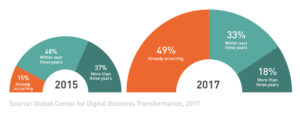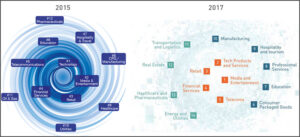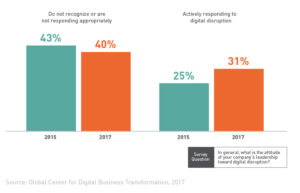
The Digital Vortex in 2017: It’s not a question of “when”
This is the first in a 4-part series of articles about digital disruption by the Global Center for Digital Business Transformation (DBT Center), a joint initiative of IMD business school and Cisco. The series explores how digital disruption is altering traditional competitive dynamics in virtually every industry – and what you can do to ensure your company thrives.
At the Global Center for Digital Business Transformation, we conduct research and analysis on digital business transformation, and prepare executives and companies for success in the digital era. One of our first initiatives was to examine with precision just what the digital age is. We aimed to determine its impact on the economy, industries and companies, as well as what strategies are being and should be used by incumbents in the face of this changed competitive environment.
In our research beginning in 2015, we saw that some industries were quickly and heavily affected by digital disruption, others less immediately. But it became apparent that all would face it at some point.
It came to us to use the analogy of a vortex to describe this phenomenon. A vortex, of course, is a whirling force that pulls everything towards its center, typically in a chaotic manner. We published an award-winning book, “Digital Vortex: How Today’s Market Leaders Can Beat Disruptive Competitors at Their Own Game”, as well as several shorter works that year.
Since then, we have been analyzing the evolution of this phenomenon and in parallel working directly with executives and companies to address their strategies amid digital disruption. We released the findings of a follow-up study in June 2017, confirming that the Vortex is indeed speeding up. Let’s have a closer look.
What a difference two years makes
A photo that briefly trended on social media in early June showed a guy casually mowing his lawn while a tornado approached behind. In 2015, there was a lot of that going on in the Digital Vortex.

Back then, only 15% of survey respondents saw themselves as being in the midst of digital disruption. More worrisome, 45% of respondents did not feel that digital disruption was a board-level concern. Well, the numbers have flipped.
In our 2017 results, nearly half the respondents said digital disruption was happening and only 17% told us that the issue was not worthy of board-level attention. It would seem that companies are intouch with the fact that disruption is not some intangible thing happening in the future, but, simply put, it’s now.

The way the Vortex looks today
In both our original 2015 study and this year’s edition we see that the manner in which the Digital Vortex is experienced varies greatly by industry. Those industries at the center of the Vortex face the most disruption while the effects are still light at the outer edges. In the digital center, business models and value chains are digitized as much as possible. The force of the vortex separates physical and digital sources of value, yielding “components” that can be readily combined to create new disruptions and blur the lines between industries. (We’ll get more into digital value creation in next week’s article.)

A look at the current Vortex picture shows that all industries are closer to the center than two years ago – none experience less disruption than before. A bit of juggling has happened in terms of relative position, but the five most vulnerable industries are the same ones as before: media and entertainment; technology products and services; retail financial services; and telecommunications. Overall, this isn’t surprising to us: most of the core offerings of these industries can be digitized (like music streaming or e-banking) and are geared towards B2C markets.
Life in the Vortex center
To understand ways that the Digital Vortex can surprise (and thus require a high level of agility if you want to survive), let’s look at what’s put media and entertainment ahead of technology to take the Number 1 spot. Virtually every media type has seen massive disruption, particularly these past two years. These changes come from technological developments, changes in consumer preferences, and strong pressures from new market entrants and digitally agile competitors.
Netflix provides a good example of digital agility and willingness to be a self-disruptor in the center of the Vortex. Founded in 1997, it’s not a new company (OK, MGM is over 90 years old), but it has rapidly, nimbly evolved its products, services and markets throughout that 20-year history.
Netflix started off providing DVD rental, with a subscription-style business model that contrasted with other providers at the time. The company expanded into streaming media in 2007, in parallel with geographic expansion. Sophisticated video-recommendation algorithms help keep clients entertained the way they want to be. Content production was added in 2013 – a success that continues to grow. Essentially, as the Vortex picks up speed, Netflix keeps ahead by disrupting itself ever-faster. Netflix has transformed the very way we consume these media – think “binge watching” – changing the competitive landscape in the entertainment market. In the lest-we-forget category: remember Blockbuster Video? They turned down an offer to buy Netflix in 2000.
More companies are getting it
A change we applaud in the new study shows that organizations are now more willing to recognize the impact of digital disruption. In fact, more than three-quarters of executives today term the impact in their industries to be “major” or “transformative” – compared to just over a quarter two years ago. The rate of active response has risen as well. But there is still a gap between trying to do something and doing it well. Forty percent of respondents told us their leaders do not understand disruption or are not responding appropriately, and only 31% state they are actively responding.

So, whilst we can report that the order of industries at highest risk of disruption in the Digital Vortex has changed, we can also report that the risk of disruption has not diminished. In fact, all the evidence points to an acceleration of change; technology and business models are in state of flux, driven by digital disruptors both from within and without industry sectors. And whilst we can further report that the leaders of organizations are more aware of the threats and opportunities, and more active in taking action, it is still the case that up to 70% of businesses are not actively responding to digital disruption.
Orchestrating digital transformation
At the IMD campus in Lausanne, we have umbrellas that are big, branded and sturdy enough to hold up against the winds that often accompany the rain in this part of Switzerland. Why is this relevant? We won’t just tell you it’s raining. We’ll hand you an umbrella. Likewise, we aren’t writing this series of articles to just tell you that you’re in the Digital Vortex. The upcoming three articles will introduce you to our framework for orchestrating your digital transformation for success in the Vortex.
Research Information & Knowledge Hub for additional information on IMD publications

Effective leadership, a clear narrative, and a shared vision are vital ingredients for bringing lasting change on sustainability.

Leaders risk getting lost in information overload and complexity. It’s time to reframe and look at the world through fresh eyes.
Alex Reinhardt was brought in to turn around a renewable-energy company that had been on the verge of bankruptcy until the German government bailed it out. After he fainted from overwork and burnout and had to take a medical leave, the board appoi...

Global market shifts and turbulence in 2025 mean Chief Financial Officers must take into account inflation, trade tensions and shifting regulations to ensure long-term growth

Swarovski CEO Alexis Nasard on leadership, redefining luxury, and driving brand transformation.

Did our predictions for 2024 come true, a turbulent election year, bitcoin and CBDC, COP29 and electric cars, China, EU integration and Euro football
Companies don’t operate in a vacuum. Corporate leaders have to navigate political dynamics, and in Chapter 12 we discuss nonmarket strategies. But there’s a global dimension to sustainability that’s worth a separate discussion. Will rising geopoli...
In a world where change is the only constant, the strategic imperative for sustainability is not just a theoretical construct – it’s a call to action. This section of the book delves into the core strategies that will enable businesses to thrive i...
In late 2020, as the world began to emerge from the worst of the COVID-19 pandemic, Wärtsilä, a Finnish corporation specializing in power systems, made a bold decision. Despite being a well-established company with a strong track record in...

Anne, a newly appointed CFO at a global manufacturing group, transitions from consultant to leader, embracing delegation, strategic thinking, and career growth.
in I by IMD
Research Information & Knowledge Hub for additional information on IMD publications
Research Information & Knowledge Hub for additional information on IMD publications
Research Information & Knowledge Hub for additional information on IMD publications
Research Information & Knowledge Hub for additional information on IMD publications
Research Information & Knowledge Hub for additional information on IMD publications
in I by IMD
Research Information & Knowledge Hub for additional information on IMD publications
in Binder, Julia Katharina (Ed.); Haanaes, Knut Bjarne (Ed.) / Leading the sustainable business transformation: A playbook from IMD, pp. 47-57 / Hoboken: Wiley, 2025
Research Information & Knowledge Hub for additional information on IMD publications
in Binder, Julia Katharina (Ed.); Haanaes, Knut Bjarne (Ed.) / Leading the sustainable business transformation: A playbook from IMD, pp. 59-62 / Hoboken: Wiley, 2025
Research Information & Knowledge Hub for additional information on IMD publications
in Binder, Julia Katharina (Ed.); Haanaes, Knut Bjarne (Ed.) / Leading the sustainable business transformation: A playbook from IMD, pp. 1-7 / Hoboken: Wiley, 2025
Research Information & Knowledge Hub for additional information on IMD publications
in I by IMD
Research Information & Knowledge Hub for additional information on IMD publications

